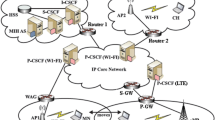Abstract
Deployment of IP multimedia services with guaranteed Quality of Service (QoS) is a primary requirement for Beyond 3G (B3G) systems. In this paper we propose a new architecture to support Internet QoS-sensitive services (e.g., video-conferencing, voice over IP, interactive gaming), thus providing users with end-to-end QoS guarantees. In particular, the paper discloses a new hybrid Intserv/Diffserv scheme for handling IP packets and an interworking procedure with the RSVP protocol which allows to support QoS over an integrated, multi-segment network. Such scheme is implemented by means of a suitable Quality of service Support Module (QASM). Advantages and drawbacks of QASM are discussed and the impact on both system architecture and Multi-Mode Mobile Terminal is investigated. Performance evaluations, carried out via computer simulations, confirm the effectiveness of the proposed solution.
Similar content being viewed by others
Abbreviations
- AN:
-
Access Network
- BE:
-
Best Effort
- CAC:
-
Connection Admission Control
- CCM:
-
Congestion Control Module
- CLS:
-
Controlled Load Service
- DIFFSERV:
-
Differentiated Services
- DLB:
-
Dual Leaky Bucket
- E2E:
-
End to End
- EDF:
-
Earliest Deadline First
- ESW:
-
Euro Sky Way
- FES:
-
Fixed Earth Station
- GPRS:
-
General Packet Radio Service
- GMBS:
-
Global Mobile Broadband System
- GGSN:
-
Gateway GPRS Support Node
- GS:
-
Guaranteed Services
- INTSERV:
-
Integrated Services
- IP:
-
Internet Protocol
- MT:
-
Mobile Terminal
- PDP:
-
Packet Data Protocol
- QASM:
-
Quality of Service Support Module
- QoS:
-
Quality of Service
- QSD:
-
QASM Signalling Datagram
- RSVP:
-
Resource Reservation Protocol
- SCTP:
-
Stream Control Protocol
- SIP:
-
Session Initiation Protocol
- TCP:
-
Transport Control Protocol
- TE:
-
Terminal Equipment
- T-IWU:
-
Terminal InterWorking Unit
- VHE:
-
Virtual Home Environment
- WLAN:
-
Wireless Local Area Network
References
Berezdivin, R., Breinig, R., & Topp, R. (2002). Next-generation wireless communications concepts and technologies. IEEE Communication Magazine.
Marques, V., Aguiar, R.L., Garcia, C., Moreno, J.I., Beaujean, C., Melin, E., & Liebsch, M. (2003). An IP-based QoS architecture for 4G operator scenario. IEEE Wireless Communications.
Conforto P., Tocci C., Losquadro G., Fedi F., Sheriff R.E., Chan P.M.L., Fun Hu Y. (2002). Ubiquitous Internet in an integrated satellite-terrestrial environment. IEEE Communication Magazine 40: 98–107
Torabi, M., & Buhrke, R. E. (1998). Third-generation mobile telecommunications and virtual home environment: A prioritization analysis. Bell Labs Technical Journal.
Mandato D., Kovac E., Hohl F., Amir-Alikhani H. (2002). CAMP: A Context-aware mobile portal. IEEE Communication Magazine 40: 90–97
Daoud F., Mohan S. (2002). Strategies for provisioning and operating VHE services in multi-access networks. IEEE Communication Magazine January 40: 78–88
Hsieh, H. Y., Kim, K. H., & Sivakumar, R. (2004). An end-to-end approach for transparent mobility across heterogeneous wireless networks. Springer Mobile Networks and Applications, 9(4).
Wedlund, E. (1999). Mobility support using SIP. In Proceedings of ACM international workshop on wireless mobile multimedia 1999, Seattle, USA.
Ma, L., Yu, F., Leung, V.C.M., & Randhawa, T. (2004). A new method to support UMTS/WLAN vertical handover using SCTP. IEEE Wireless Communicatons, 11(4).
Morand, L., & Tessier, S. (2002). Global mobility approach with mobile IP in “All IP” networks. In Proceedings of IEEE International Conference on Communication 2002, New York, USA.
IEEE P802.21/D00.02 (2005). Draft IEEE Standard for Local and Metropolitan Area Networks: Media Independent Handover Services.
Cacace, F., & Vollero, L. (2006). Managing Mobility and Adaptation in Upcoming 802.21Enabled Devices. In Proceedings of ACM WMash 2006. Los Angeles, USA.
Dutta, A., Das, S., & Famolari, D. (2005). Seamless Handover across Heterogeneous Networks—An IEEE 802.21 Centric Approach. In Proceedings of IWS-WPMC 2005. Aalborg, Denmark.
Moon B., Aghvami H. (2001). RSVP extensions for real-time services in wireless networks. IEEE Communication Magazine 39(12): 52–59
Braden, R., Clark, D., & Shenker, S. (1994). Integrated services in the internet architecture: An overview. IETF RFC 1633.
Braden, R., et al. (1997). Resource reservation protocol (RSVP)—version 1 Functional specification. RFC 2205.
Elwalid, A., & Mitra, D. (1997). Traffic shaping at a network node: theory, optimum design, admission control. Proceedings of IEEE-INFOCOM, 2. Kobe, Japan.
Lin A.Y.M., Silvester J.A. (1991). Priority queueing strategies and buffer allocation protocols for traffic control at an ATM integrated broadband switching systems. IEEE Journal on Selected Areas in Communications 9: 1524–1536. 1991.
Delli Priscoli, F. (1999). Design and implementation of a simple and efficient medium access control for high speed wireless local area networks. IEEE Journal on Selected Areas in Communications (JSAC), 17(11); IEEE Communications Society (U.S.A.), 2052–2064.
Sahu, S., Towsley, D., & Kurose, J. (1999). A quantitative study of differentiated services for the internet. UMass CMPSCI Technical Report 99–09. Also in Proc. of IEEE Global Internet, GLOBECOM’99, Rio De Janiero (pp. 1808–1817).
Bianchi, G., Blefari Melazzi, N., & Femminella, M. (2002). Per flow QoS support over a stateless differentiated services IP domain. Computer Networks, 40(1).
Third Generation Partnership Project, Technical Specification Group Services and System Aspect. (2002). General Packet Radio Service (GPRS) Service description, TS 23.060 Release 5, 3GPP Organization Partners.
Third Generation Partnership Project, Technical specification Group Services and System Aspect. (2002). End-to-end QoS Concept and Architecture, TS 23.207 Release 5, 3GPP Organization Partners.
ETSI GSM 03.60 v7.3.0, Digital Cellular Telecommunications System (Phase 2+); General Packet Radio Service (GPRS); Service Description; stage 2, 1998.
Third Generation Partnership Project, Technical specification Group Services and System Aspect. (2002). Quality of Service (QoS) Concept and Architecture, TS 23.107 Release 5, 3GPP Organization Partners.
Carducci, F., & Losquadro, G. (1999). The EuroSkyWay worldwide system providing broadband service to fixed and mobile end-users. Wiley International Journal of Satellite Communications, 17(2–3).
Author information
Authors and Affiliations
Corresponding author
Rights and permissions
About this article
Cite this article
Dini, P., Delli Priscoli, F. A Quality of Service Support Module (QASM) for a Wireless Multi-Segment Integrated 3G Network. Wireless Pers Commun 43, 1781–1800 (2007). https://doi.org/10.1007/s11277-007-9346-4
Received:
Accepted:
Published:
Issue Date:
DOI: https://doi.org/10.1007/s11277-007-9346-4




